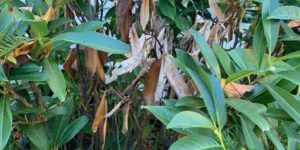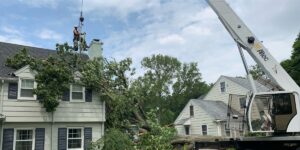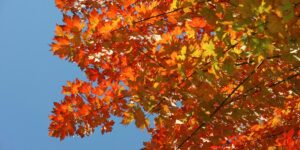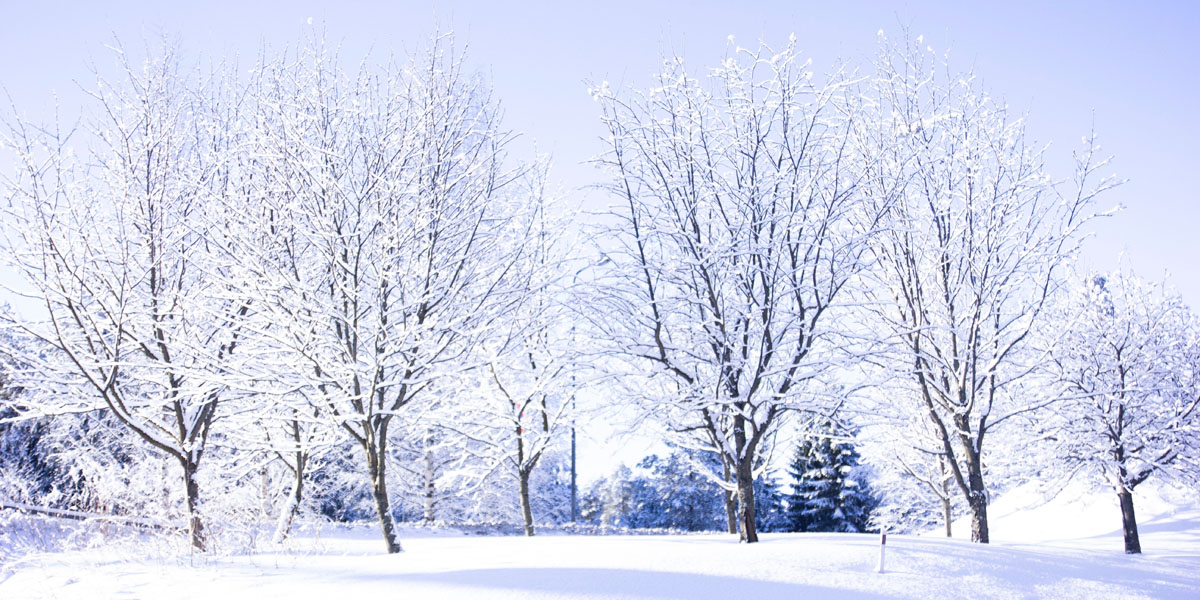You might be thinking: what’s a Hemlock Woolly Adelgid, and why haven’t I heard of it? While this invasive insect pest may not be familiar to you, if you live in New Jersey and have hemlock trees you’ve probably come across it.
Many of our customers aren’t familiar with the Hemlock Woolly Adelgid (Adelgestsugae). Nor do they realize how quickly and easily it damages and kills hemlock trees (Tsuga canadensis). The Eastern hemlock is a critical keystone species that’s under attack in New Jersey, as well as large parts of the northeast. Losing it would be an environmental disaster. (Scroll down to find out why)
We’ve put together this article to help you understand why it’s important to control Hemlock Woolly Adelgid in New Jersey. Specifically, we’ll tell you:
- What the Hemlock Woolly Adelgid is
- How it damages and kills hemlock trees
- How to identify it and where you’re likely to find it (if it’s on your trees, you definitely want to know!)
- Ways to tell if you have a hemlock on your property (versus pine, fir, or spruce trees)
- Why eastern hemlocks are so important to our environment and why we need to save them
- The various options for Hemlock Woolly Adelgid treatments and when you should treat for HWA
- What you can do (and not do!) to prevent the spread of HWA
What is a Hemlock Woolly Adelgid?
The Hemlock Woolly Adelgid (HWA) is an invasive, aphid-like insect that damages or kills hemlock trees by piercing their bark and sucking out the sap. This damage doesn’t immediately kill the tree but, if allowed to progress, starts a process of slow decline that ends in death.
HWA was brought to the U.S. sometime in the early 1900’x. We don’t know exactly how or when HWA arrived, but it most likely caught a ride on imported hemlock trees. In its native range in East Asia, this destructive insect has insect predators that keep its population in check. But in New Jersey and all of the areas of the U.S. where HWA has established itself, there are no native predators. As a result, this invasive pest has spread unchecked.

The distinctive white egg sacs of HWA are found at the base of hemlock needles. Image courtesy of Steven Katovich, Bugwood.org
Identifying the Hemlock Woolly Adelgid
You may not notice hemlock woolly adelgid without a magnifying glass. They’re very small; just a few millimeters long (or .06 inches). They like to be at the base of hemlock needles, usually on the underside.
It’s the signature “wool” enclosure of HWA that is their most identifiable characteristic. This isn’t real wool – it’s a waxy secretion that protects the insect.
You’ll find masses of eggs on the underside of leaves, as well as larvae (called “crawlers”). Eggs are present throughout the year, with larvae hatching during times of the year when survival is most likely.
These adelgids usually produce two generations of young each year, with each egg mass containing up to 200 eggs. That’s up to 200 eggs laid each year per generational female HWA, which gives you an idea of how quickly this insect reproduces and spreads! Oh, and they reproduce asexually, so male HWA isn’t needed.
NOTE: The only upside of this asexual reproduction is that it makes an insect species less likely to evolve, and less adaptable to changes in its surrounding environment.
How To Find Hemlock Woolly Adelgids On Your Trees
First, verify that you have eastern hemlock trees, as this is the only tree species the adelgid will be found on. Since there are other insects that make protective covers that look similar to the “wool” of the HWA, you’ll want to be sure you’re looking at an infested eastern hemlock and not another type of tree and another insect.
A tiny spider egg sac, for example, may look like it’s a hemlock woolly adelgid but you don’t want to kill spiders! Hardly anyone wants spiders in their house but outside, on trees, those spiders make our lives better by eating unwanted insect larvae and catching flying insects in their webs.
Eastern hemlocks look similar to other common evergreen conifers, so make sure your tree is not:
- Fir (Abies species),
- Pine (Pinus species), or
- Spruce (Picea species).
How To Tell the Difference Between Hemlocks, Pines, Firs, and Spruces
Hemlocks are most easily identified by their short, flat needles. Their needles are shorter than pine needles and are shaped differently from fir and spruce.
Hemlock needles are:
- About half an inch long
- Flat, while pine and spruce have round needles
- Striped white on their undersides (fir tree species also have needles with white stripes on their underside, so rely on the length of the needle to tell the difference)
- Wider and more rounded than fir or Douglas fir (Pseudotsugamenziesii) needles
Once you know your trees, check the top and the underside of your hemlock’s needles for signs of Hemlock Woolly Adelgid. Look at the base of a needle for the tell-tale white masses.
Why It’s Important to Learn to Identify and Treat HWA
Many invasive insects like Hemlock Woolly Adelgid have no natural predators. As a result, they can wreak incalculable damage to native forests, woodlands, and designed landscapes of all sizes, including parks, trails, and residential gardens. The insect’s goals are to eat and reproduce. It doesn’t care about much else, including the tree it depends on.
Our native hemlock trees have no natural resistance to HWA infestations. Once infested, a tree responds by isolating the affected area, cutting off water and nutrients to it, and killing that portion of the tree. Needles turn brown or gray, and new twig and leaf growth stop. After several continuous years of infestation, the tree will decline and die.
Older and more valuable hemlocks die faster than young hemlocks. And any hemlock will die more quickly when exposed to environmental stressors, such as high heat and drought (conditions that are becoming more frequent with climate change).

Close-up showing the tiny HWA crawlers. Image courtesy of Pennsylvania Department of Conservation and Natural Resources – Forestry, Bugwood.org
Why You Should Protect Hemlocks from Infestation By HWA
Hemlocks are ecologically important to our region’s forests and native woodlands. They are a keystone species, meaning that:
- hemlocks’ presence is vital to their ecosystem,
- their value and contribution are unique to their ecosystem, and
- the disappearance of hemlocks will degrade their ecosystem.
NOTE: Cornell University has a website that provides information about the Hemlock Woolly Adelgid, as well a clear and detailed guide to identifying HWA.
Why the Eastern Hemlock is So Important
Unlike many other coniferous evergreens, hemlocks are shade tolerant. This means that they can grow where other conifers can’t. By growing in (and creating) shady areas, they preserve the health of these ecosystems.
Here are some of the many benefits hemlock trees provide:
- Hemlocks grow beside bodies of water, keeping water temperatures lower so that fish and other aquatic species can survive.
- Hemlocks are long-lived trees, so they prevent invasive tree species and less valuable tree species from overtaking and changing the ecosystem.
- Hemlocks grow on steep slopes, keeping them stable and preventing erosion.
- The canopies of hemlock trees keep the soil cool and retain moisture, preserving understory plants.
- Hemlocks’ evergreen canopies slow rainfall and runoff and protect smaller plants from snow and wind damage.
- The cool, dark, and sheltering ecosystem hemlocks create provide forage and habitat for large mammals and birds.
Hemlock Woolly Adelgid Treatment
There are several methods to manage and control hemlock woolly adelgid infestations, but the most common method is spraying.
Spray with Horticultural Oil or Insecticidal Soap
Spraying non-toxic horticultural oils and insecticidal soaps before bud break and intermittently throughout the growing season can effectively smother adelgids, stopping their spread. We recommend spraying dormant oil before new needles emerge in spring. During the growing season, it’s best to use more lightweight horticultural oils and insecticidal soaps.
If you have dwarf Canadian hemlocks, you may be able to manage this yourself. Just be sure to get 100% coverage on all surfaces of the tree when spraying, including the tops and bottoms of all needles. Any areas of a hemlock’s crown that you miss when spraying will allow HWA to survive, reproduce, and re-infest your trees.
For large hemlocks and larger stands of landscape trees, you’ll need a professional pesticide applicator to do the job. It takes high spray pressure to reach all parts of a larger hemlock’s crown and to thoroughly cover the needles – much higher pressure than your typical hose-end sprayer, pressure washer, or compressor can produce.
That’s why it’s essential to hire a certified arborist (like Alpine Tree) with the training, experience, and professional equipment to ensure complete coverage of infested trees. An experienced arborist can also prevent spray drift and unintended damage to other nearby plants.
Use Pesticides for Larger Trees
For larger trees, you’ll need more intensive controls that must be professionally applied.
Several commercial insecticides and injections are effective in controlling woolly adelgid in mature trees. The key to success is proper timing and thorough application.
The shortcoming of pesticide sprays is their limited use. While you can spray individual trees or small groups of hemlocks, you can’t spray whole forests or entire hemlock ecosystems. Plus, the broad-spectrum nature of pesticides means that important insect, fish, and invertebrate species may be wiped out if pesticides are sprayed repeatedly and extensively.
When to Spray Hemlocks for HWA
Apply foliar sprays to target pests, like HWA, during the most vulnerable stage(s) in their lifecycle. The most effective times to spray are in spring and summer, between May and June, and again between late July and through October. Temperatures and weather events will determine the best times to spray; don’t apply when temperatures are 90 degrees or above and don’t apply when rain is imminent.
NOTE: Some commercial pesticides can only be purchased, mixed, and sprayed by professional applicators. This is because the pesticides can kill trees, shrubs, and beneficial insects if they are applied incorrectly. Alpine Tree has a NJDEP Pesticide Applicator Business License (#91603B) and is qualified to apply the kinds of pesticides used to control hemlock woolly adelgid.
The most common commercial pesticide sprays are imidacloprid (Merit®) and Dinotefuran. Used together, these two pesticides provide short- and long-term protection against Hemlock Woolly Adelgid, protecting hemlock for up to seven years. Merit controls HWA by contact spray to foliage and through ingestion by the insect from a systemic, soil application. Dinotefuran is a broad-spectrum foliar insecticide and a neonicotinoid. This type of pesticide is known to kill bees and beneficial pollinators; only use it if absolutely necessary, and then sparingly.
Biological Control of HWA
There is not yet an available biological control for HWA, but research and testing are ongoing. Some natural predators of HWA have been introduced from the pest’s native Asian range into areas of infested hemlocks, with some success. Another native beetle from the west coast has been released in some infested hemlock stands and is promising, but this approach is still being scientifically tested.
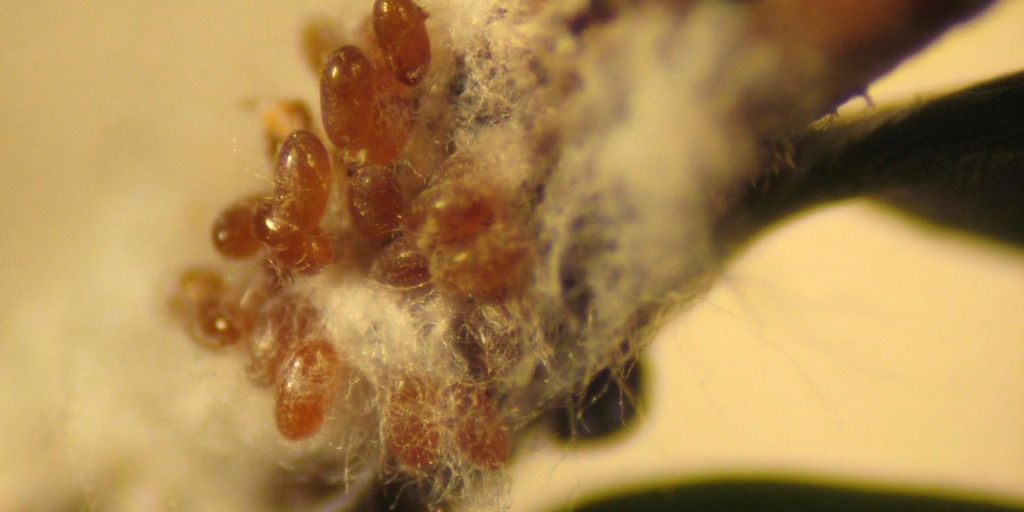
Hemlock woolly adelgid eggs surrounded by the characteristic white “wool” produced by the adult adelgid. Image courtesy of Shimat Joseph, University of Georgia, Bugwood.org.
How to Stop the Spread of Hemlock Wooly Adelgid
Some HWA can fly, but the majority of them don’t have wings and can only move around by crawling. These crawlers can spread by being blown about by wind gusts and storms, being carried by migratory birds when eggs or crawlers stick to their feathers, by other wildlife, and, of course, by humans.
Some New England states have quarantines on hemlocks and hemlock products, including nursery plants. While New Jersey doesn’t yet have a Hemlock Woolly Adelgid quarantine, residents, landscapers, and arborists should understand how their actions might expand the HWA’s range.
Fortunately, it’s hard to move this particular invasive insect. Feeding insects and egg-laying females will stay where they are once they’ve installed themselves on twigs and branches. HWA eggs are the easiest to move, along with crawlers, but only during certain times of the year when they are active or loosely attached to foliage.
Tools and equipment can inadvertently spread hemlock woolly adelgid by carrying eggs or crawlers between uses at different locations. If you’ve been working in an area near hemlock trees, inspect and disinfect your tools and equipment before you leave – even if you don’t think the trees are infested.
HWA can also spread through branch clippings. While many agricultural extension services allow people to send in cuttings of diseased or infested leaves and branches for identification, don’t do this with hemlock twigs or branches! Similarly, don’t transfer or dump green waste from infested hemlocks, and don’t place hemlock clippings in your compost pile. Although it’s difficult for the Hemlock Woolly Adelgid to get from the ground up into the crown of a tree, it’s not worth taking the chance.
What to do if your Hemlock has Woolly Adelgids
You can help infested hemlock stay healthier for longer by removing anything that could stress your trees. Here’s what to do (and not do):
- Keep hemlocks well watered during dry spells or drought conditions.
- Spread a layer of organic mulch out to the dripline. This will protect their roots, retain soil moisture, and increase soil nutrients. Just be sure all mulch is pulled well back from the base of the tree.
- If possible, prune off badly infested branches. Place the cut branches in plastic bags, and dispose of them in the trash – never put them in the compost or use them as mulch!
- Don’t fertilize hemlocks until the adelgids have been eradicated. Gertilizers high in nitrogen encourage new growth, providing more food for HWA and increasing their numbers.
Need a Hand?
If you have hemlock trees on your property, give us a call. We are devoted to tree health and understand the ecological value of hemlocks in your garden and in the larger ecosystems and forests of New Jersey. We can diagnose the presence of HWA (or reassure you that it’s another, treatable pest you’re seeing). We can also recommend control measures, such as spraying, that can reduce or eliminate infestations, and monitor your trees to make sure Hemlock Woolly Adelgid populations don’t return or expand.


